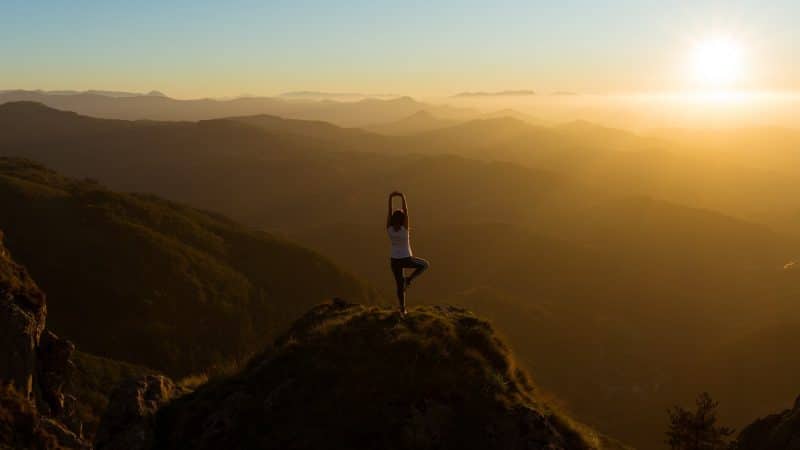34 Life-Altering Yoga Statistics & Facts for a Balanced 2024

If you’re new to the relaxation yoga provides, or you want to learn amazing new things about this ancient practice, you’re in the right place. In this article, beginners and advanced yogis alike can learn about the most interesting yoga statistics and facts from different parts of the world.
So put on some calming music, grab a hot cup of tea, and take a deep breath, because here are the ultimate stats on yoga that will convince you to start the practice today.
Top 10 Most Fascinating Yoga Statistics and Facts
Yoga Statistics in the US
The US is the largest market for the yoga industry and the country with the most yoga practitioners in the world. Let’s take a closer look at some of the most important figures on this ancient practice in the US.
[visualizer id=”98174″]
Source: Statista
1. Yoga is practiced by 8.7% of Americans.
(YogaUOnline)
This means that 20.4 million Americans are doing yoga. The numbers are based on data from the most recent survey by Yoga Journal, which also claims that there are more people practicing yoga now than there were in 2004. In fact, there were only 15.8 million yogis in the US in 2004, yoga stats show.
2. 56% of the US yoga practitioners consider themselves beginners, facts about yoga reveal.
(Yoga Alliance)
According to the data, 30% of Americans have practiced yoga for less than a year, and an impressive 56% consider themselves new to the practice. Even though only 2% are deemed advanced practitioners, this information clearly shows that more and more people are becoming interested in yoga, hoping to be experts themselves one day.
3. Yoga demographics and stats show that 72% of practitioners in the US are women.
(Yoga Alliance)
Even though the ancient practice is suitable for both men and women, it’s almost entirely dominated by women in the US. One of the reasons yoga may be more popular among women is because the industry’s marketing specifically targets this group when selling products such as yoga mats, water bottles, and juice cleanses.
4. However, yoga statistics also show that 28% of yogis in the US are men.
(DoYouYoga)
More and more men are getting in touch with their Zen. The number of male yogis increased from 17.8% in 2012, reaching 10 million in 2016. Some of the most popular yoga poses for men include the standing forward fold (or uttanasana), chair pose, downward-facing dog, and half pigeon.
5. Interestingly, 34% of individuals in the US say they’re likely to try the ancient practice, facts about yoga show.
(PR Newswire)
Trying yoga out can be quite daunting, especially if you don’t have an experienced practitioner to guide you. According to 2016 stats, less than half of the US is willing to try yoga in the following 12 months.
6. In the US, 38% of the individuals who practice yoga are over 50.
(Yoga Alliance) (Harvard Health)
According to some interesting facts about yoga, the number of US yogis over 50 has almost tripled over the last four years! In fact, experts suggest that women over 50 start incorporating more yoga into their lives because it may improve strength and flexibility. Similar to the top-rated rowing machines, yoga will provide a full-body workout without putting stress on your joints — perfect for users of all ages.
7. 54% of yoga practitioners say their main goal is to release tension, fun facts about yoga show.
(Eventbrite)
Most yogis become interested in yoga to find their inner peace and hopefully reduce the stresses of everyday life. Other reasons why people get into yoga include boosting mental and physical strength (52%), improving mood (43%), and dedicating more time to themselves (27%).
8. Yogis spend an average of $62,640 on yoga, including workshops, classes, and accessories.
(Eventbrite) (Statista)
This translates to almost $90 a month. Yogis are super committed, not just with the money they spend, but also the time they devote to the practice. According to 2019 statistics, 44% of yogis do yoga two to three times a week, whereas an older survey shows that 89% dedicate one to five hours each day to this practice.
9. The average yoga instructor hourly rate is $25.00.
(PayScale)
An entry-level yoga teacher in the US (with less than one year of experience) earns around $20.53, while an experienced yoga instructor might earn up to $35 an hour. Yoga instructors need to have a full understanding of all types of yoga, as well as be physically able to provide the students with practical instruction.
10. Classes in the US are expected to operate at 25% to 50% capacity in line with COVID-19 guidelines.
(Forbes)
According to studio owners’ surveys and yoga statistics for 2021, operating at a lower capacity is just one of the changes in store for yoga studios following the pandemic. Many studios say that they will no longer rent mats and props to students, as well as avoid hands-on adjustments of positions. They also expect prices and membership fees to go up and see an increase in the number of online classes.
Yoga Statistics in the UK
After reading up on some amazing facts about yoga in America, it’s time to move across the Atlantic and learn more about yoga in the UK.
11. There are 300,000–460,000 yogis in the United Kingdom.
(Finder) (The British Wheel of Yoga)
It isn’t a surprise that the Sports Council recognized the British Wheel of Yoga as the national governing body for the ancient practice in the United Kingdom. According to the most recent numbers, almost half a million people in the UK practice yoga.
12. An average yoga teacher pay rate in the UK ranges between £12,500 to £25,000 a year.
(National Careers Service) (Finder)
There are more than 10,000 active yoga instructors in the UK. Individuals who want to become qualified yoga instructors can turn to the British Wheel of Yoga, where a diploma and a level four certificate is offered to the best of the best. According to yoga participation statistics in the UK, all these yoga instructors teach between 20,000 and 30,000 classes each week.
13. The yoga and pilates industry was worth over £926 million in 2020.
(Finder)
According to the 2020 statistics and facts about yoga in the UK, there was a 6% increase in this market from the year before. Pilates is considered a practice similar to yoga in the sense that it also alleviates high-stress levels, promotes physical activity, and increases focus.
14. Interest in yoga spiked at the start of the coronavirus pandemic.
(Finder)
Not only did the internet interest in yoga hit the highest numbers in March 2020, but the peak also lasted longer than previous spikes, which usually coincide with New Year’s Resolutions. Once restrictions were lifted in the summer, search interest dropped to regular levels.
Yoga Statistics Worldwide
This section will tell you all you need to know about yoga popularity by country as well as some exciting figures and data on the practice from all over the world.
[visualizer id=”98182″]
15. In 2016, there were 754 yoga facilities in Beijing.
(Statista)
The Chinese seem to be die-hard fans of the ancient Indian practice. Based on a graph representing the number of China’s yoga facilities and their locations, the most yoga centers are located in Beijing, followed by Shanghai and Guangzhou.
16. There are more than 300 million yogis all across the globe.
(Yogi Times)
According to the global statistics on yoga, the accessibility of this practice across all ages and genders in multiple countries contributes to its growing popularity. Actually, most cities nowadays have at least one local yoga school or yoga center.
17. The global yoga industry generated $37.46 billion in 2019.
(PR Newswire)
The market is expected to grow by a staggering 9.6% up to 2027 despite COVID-19 restrictions, yoga statistics from 2021 onwards forecast. Even though the offline yoga segment is expected to maintain its leading position on the market, the online component is projected to experience the highest growth of 12.3% up to 2027.
18. More than half of the yogis in the world are Indian.
(ETHealthWorld)
Even though yoga is practiced worldwide, not many are aware of the fact that its birthplace is beautiful India. Based on data from a 2017 study examining global yoga statistics and yoga in India, over half of the yogis in the world are originally Indian. In fact, many Indians consider yoga one of their most valuable cultural exports.
19. The number of yogis in Japan has risen by 413% in the past five years.
(Yogi Times)
Statistics on yoga popularity by country show that the public interest in the practice has especially risen in different parts of Japan. An increasing number of yoga retreats have opened all across the country, with several in Hakuba, Ishigaki, Myoko, Nagano, and Tokyo. Japanese yoga helps individuals improve mental clarity, release mental and emotional tension, and enhance muscle tone.
20. Yoga is one of Australia’s favorite cardio, strength, and flexibility exercises.
(Roy Morgan)
The latest data indicates that there are 2.18 million yogis in Australia, more than pilates (with 1.2 million participants) and aerobics (1 million participants). This activity is most popular among younger generations—16% GenYers do yoga regularly or occasionally.
21. According to global yoga demographics and figures, 21% of Canadians practice yoga.
(Léger)
Around one in five Canadians say they do yoga, which indicates a rise in popularity. Even more optimistic 2019 statistics reveal a growing interest among the younger population. Compared to older generations, 35% more Canadians aged 18 to 34 do yoga.
22. Around 30% of the Dutch prefer mindfulness or meditation yoga.
(Statista)
Based on yoga meditation facts and statistics, this form emerges as the most popular in the Netherlands. What’s more, 25% preferred Hatha yoga, while only 10% practiced Bikram, making it the least favorite form of yoga among Dutch respondents.
23. Vinyasa Flow and Hatha Yoga are the most popular styles of yoga.
(DoYouYoga) (VedaNet)
Based on a survey of 147 countries, 57% of respondents named Vinyasa Flow as their number one choice. This style is flexible, fast-paced, and easily customized to all students. Coming in second as the favorite of 42% of respondents is Hatha Yoga, the perfect style for beginners as it’s slower-paced. The oldest style of yoga, though, is Vedic Yoga, which dates back to the Rig Veda—the oldest book in the world, fascinating yoga history facts tell us.
24. Tao Porchon-Lynch was the world’s oldest yoga teacher.
(Prevention)
Tao Porchon-Lynch, who died in February 2020 at the age of 101, was the world’s oldest yoga instructor. Born in India, she had been practicing yoga since she was eight, saying that the key to a long and happy life was an active lifestyle.
25. One of the most amazing facts about yoga is that new styles and workshops emerge every day.
(Eventbrite)
A 2019 survey revealed that 20% of respondents would be interested in trying laughter yoga, while 21% stated that they would like to see spa treatments incorporated in their classes. Other experimental types of yoga include silent disco yoga, beer yoga, and even naked yoga. So, any idea, no matter how innovative, can be included in yoga workshops for an unforgettable experience.
Yoga and Health Statistics
In addition to calming the mind, yoga also heals the body, helps you lose weight, and improve balance. Keep on reading to find out more facts about yoga benefits and the impact this practice can have on your health and wellbeing.
26. More than 55% of yogis say that this activity has improved their sleep.
(NIH)
According to a national survey, there are numerous benefits of yoga. An astounding 85% of yogis said they experienced a stress reduction, while more than 80% of practitioners reported improved overall health. With this in mind, it’s no wonder why over 90% of respondents use yoga for wellness, and 15% do yoga to treat a health condition.
27. Interesting facts about yoga show that at least one session a week can help individuals lose around 5 lbs.
(Prevention)
A study on 15,000 overweight adults over the age of 50 found that the participants who practiced yoga once a week for around four years lost an estimated 5 lbs. In contrast, those who didn’t practice as much gained 13.5–20 lbs.
28. Practicing yoga can lower total cholesterol levels by 23.3%, yoga statistics and data indicate.
(PubMed)
A study of heart disease patients found that one year of yoga training, along with a healthy diet and stress management, could reduce total cholesterol levels by 23% and reduce “bad” cholesterol levels by 26%. On top of that, this regime stopped the progression of heart disease in almost half (47%) of the patients.
29. Practicing yoga can improve lung capacity.
(The Wellness Institute) (Shape)
A month of active yoga can reduce the average respiratory rate from 13.4 breaths a minute to 7.6. What’s more, combining yoga with a healthy diet and immunity-boosting supplements can help the body fight the flu and colds.
30. Fascinating facts about yoga benefits show that this practice could reduce chronic pain.
(PubMed)
A pilot study of participants over 50 years of age discovered that practicing yoga is a feasible treatment for OA patients and can significantly reduce pain and improve function. Yoga can also boost balance and flexibility, as proven by a study of 66 elderly participants. Those involved in the study noticed a four-fold increase in flexibility in just one year.
31. Yoga encourages people to try other forms of exercise.
(Yoga Alliance)
According to yoga statistics, more than three-quarters of yogis also engage in different types of exercise, such as running (36%), cycling (24%), weight lifting (30%), and group activities (37%). These numbers are significantly higher than those of non-practitioners, showing that yoga leads to a healthier and more active lifestyle.
Yoga Injuries Statistics
Yoga, although beneficial, is not without risks. Check out some important information on the most common injuries you could avoid by talking to a qualified yoga teacher.
32. 10% of individuals who’ve attempted yoga experienced musculoskeletal pain.
(Healthline)
That is definitely one of the not so fun facts about yoga. Even though some people practice yoga to alleviate musculoskeletal pain, a study conducted on 354 people found that the practice may instead be a cause of the condition. What’s more, it was discovered that yoga could inflame 21% of existing injuries, which is why it’s best to discuss the risk of musculoskeletal pain with your instructor.
33. There’s a 13.3% likelihood that yogis will experience pain in the elbows, hands, or shoulders.
(The Guardian)
A small percentage of surveyed participants reported experiencing new pain in different body parts, such as the wrists. To prevent wrist pain, yogis should keep proper form and warm up before practice.
34. Yoga statistics on injuries show that 74% of yogis experience less lower back and neck pain.
(The Guardian)
Even though yoga poses such as downward dog and pigeon may put a significant amount of weight on the extremities, there’s good news too. Most people also claimed that the practice helped them alleviate symptoms of pain in the body.
Conclusion
This ancient Indian discipline has been practiced for thousands of years, providing individuals of all ages and skill levels with heaps of benefits. Nevertheless, as the yoga statistics in this article have shown, the practice comes with a few risks, so it’s vital to consult a medical expert and a qualified instructor before committing to it.
Once this step is complete, you can start to enjoy the many advantages that come with yoga and be well on your way to a calmer mind and a more relaxed body.
FAQs
Is yoga scientifically proven?
There is a growing body of scientific studies and trials that confirm the benefits of yoga on the mind and the body. In fact, the benefits of yoga range from stress reduction and quality sleep promotion to chronic pain alleviation and overall improvement of the quality of life, balance, and flexibility.
Does yoga really help with anxiety?
Yes, yoga is an excellent way to combat anxiety and panic attacks. According to the experts, asanas, or yoga poses, could help people struggling with anxiety as they stretch tight muscles and balance the mind. You could also look into the best online therapy sites should you need additional help.
How many times a week should I do yoga?
According to professionals, the wonderful benefits of yoga may be felt even if the person decides to practice it for only an hour every week. However, it’s best to practice yoga more frequently, ideally daily or 2 to 3 times a week.
What are the disadvantages of yoga?
There aren’t many disadvantages to yoga, although it’s not without unwanted consequences. Some of these include making existing injuries worse or overdoing it and pulling muscles, ligaments, or tendons. These issues can be avoided, especially if you work with an experienced instructor. All in all, take it slowly and combine yoga with a healthy lifestyle, such as getting quality sleep on the best organic mattress or eating the right kind of food.
Where is yoga most popular in the world?
As the birthplace of yoga, it’s not surprising that India is also one of the best places for yogis. Rishikesh, known as the Yoga Capital of the World, and Goa, which offers the best of tradition and the modern, more luxurious side of yoga, top the list of the most popular yoga destinations in the world. Other countries on the list that constantly make it to yoga statistics include Spain, Thailand, Indonesia, and Portugal.






